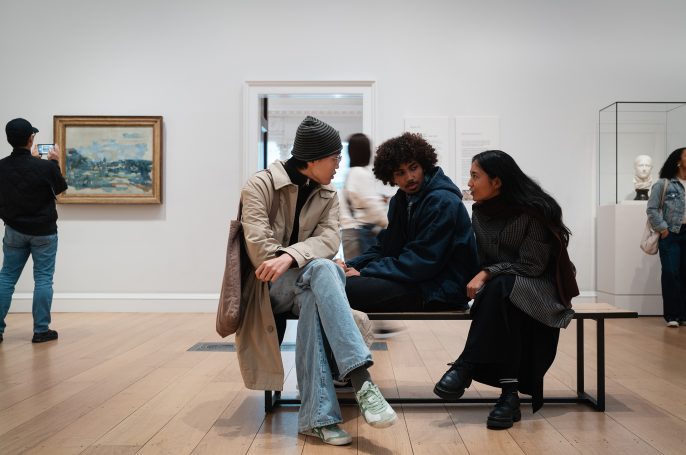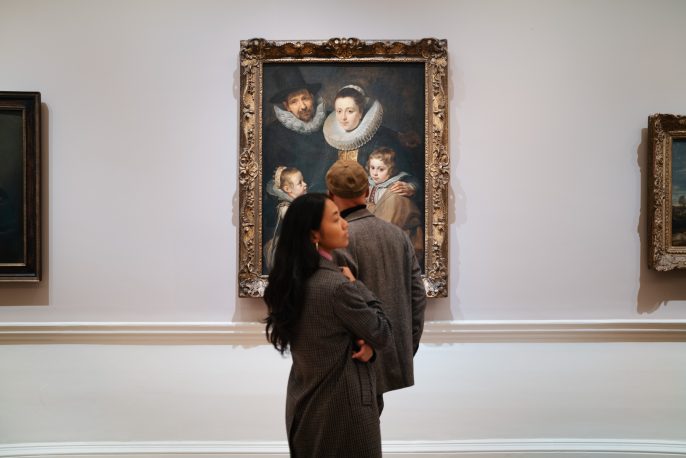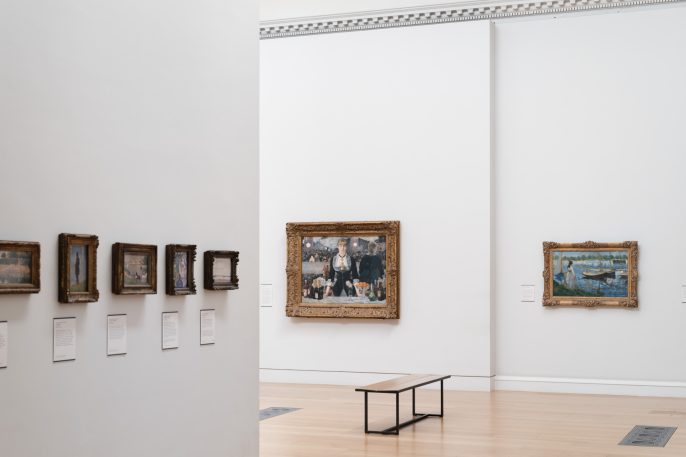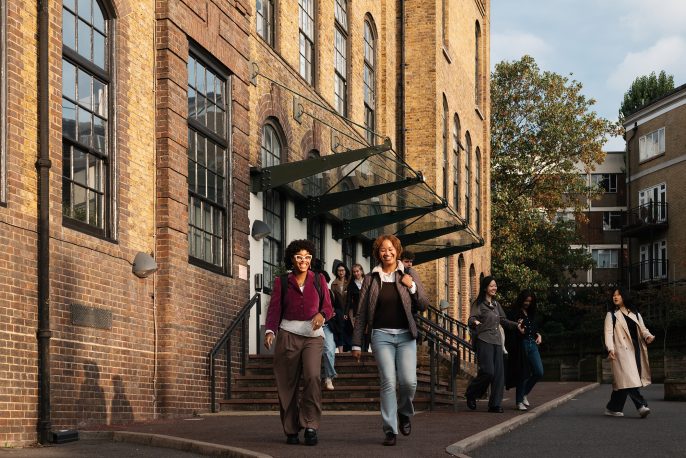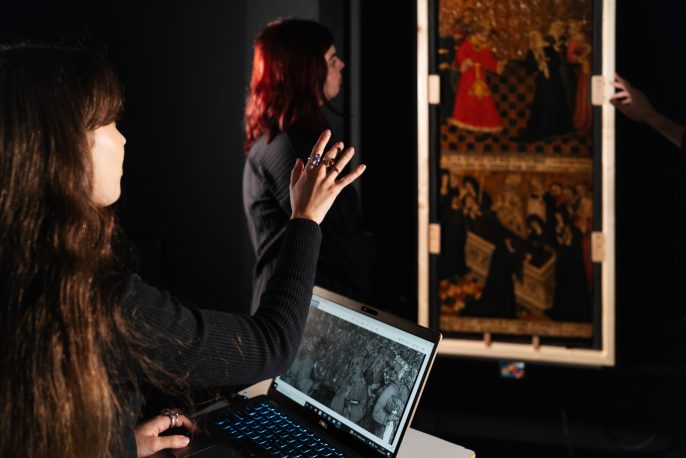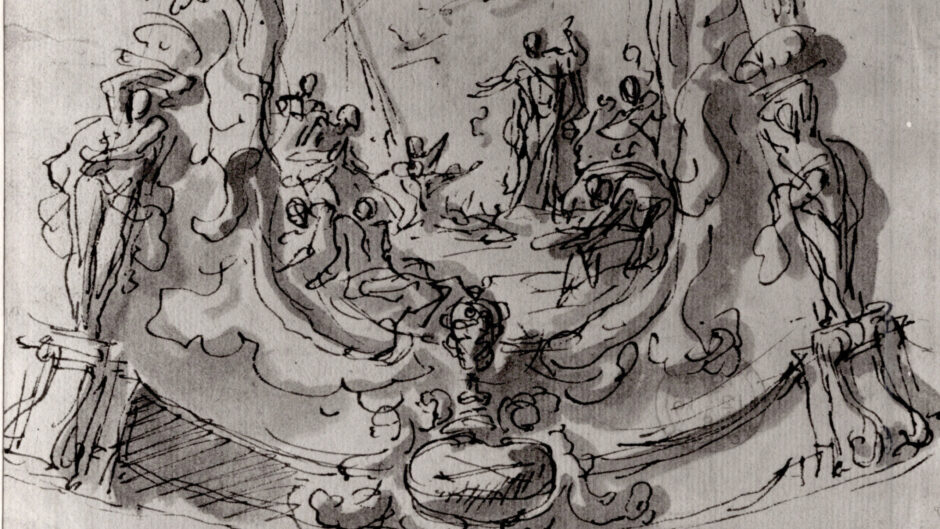Panel discussion
Chair:
Sarah Pinchin, Historic Royal Palaces / Icon Stone & Wall Painting Group
Participants:
Jonathan Deeming, Heritage Architect, Purcell
Katy Lithgow, formerly Head of Conservation, National Trust
Peter Martindale, Peter Martindale Conservation
Ruth McNeilage, McNeilage Conservation
Nigel Walter, Archangel Architects
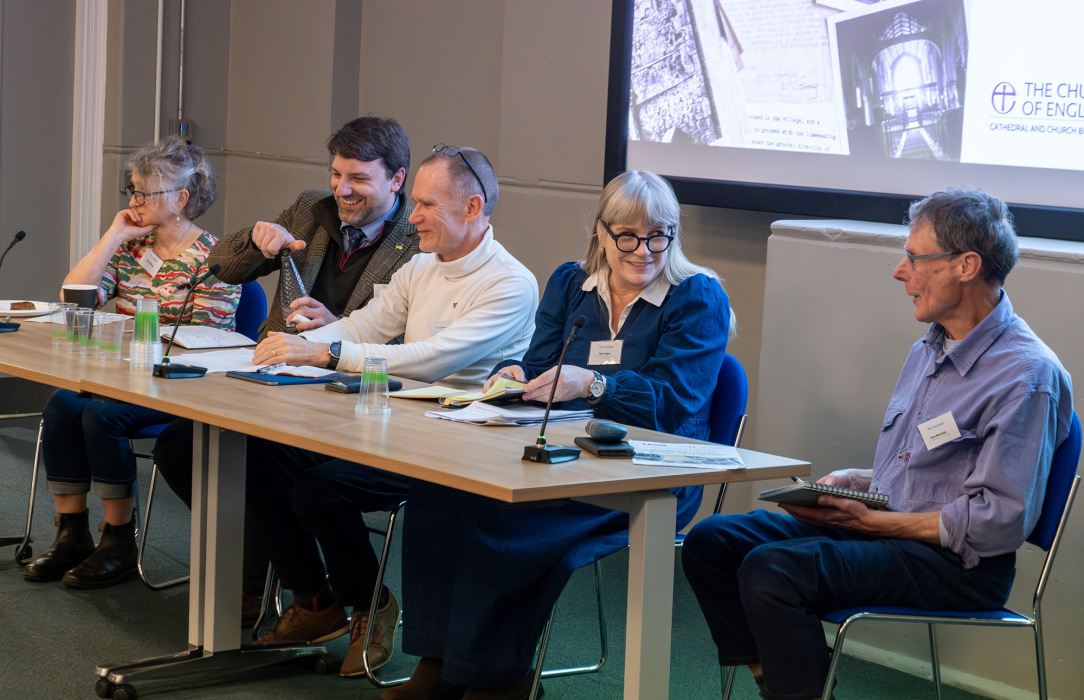
SP: This is a panel session on collaborative approaches to wall painting conservation projects. My name is Sarah Pinchin. I’m a Commissioned Treatment Coordinator at Historic Royal Palaces and I’ll be the session chair. Tobit Curteis very aptly introduced this topic, of the importance of collaboration and understanding everyone’s role and what they’re doing on a project, and I’m hoping we’re going to be able to dive deeper into this topic in the panel because we have a group of diverse experts here.
There are three topics that I’m hoping the panellists will highlight over this hour. The first emphasis will be to reflect on the reality and complexities for different professionals working on wall painting conservation projects and research right now. After that, we’ll look at the bigger picture and question how projects should work in the future. And finally, we will examine the focus of the day, archival resources and documentation and how these have been used – how these are being used now and how these will develop going forward.
Our panel of experts is composed of two wall painting conservators in private practice: Peter Martindale is director of Peter Martindale Conservation. He’s an assessor [with the Institute of Conservation] for PACR, he served on Icon’s board of trustees and the Icon Stone & Wall Painting Committee and is a fellow of IIC. Ruth McNeilage is a partner in McNeilage Conservation and has also been a long-standing member of the Icon Stone & Wall Painting Committee.
We have one conservation manager at a heritage organisation: Katy Lithgow was Head Conservator for the National Trust until 2019, she was a trustee of the National Heritage Science Forum and Chair of Icon’s PACR Accreditation Committee, winning the Plowden Medal in 2020. Katy chairs Historic England’s Historic Estate Conservation Committee and is a member of Southwark Cathedral’s Fabric Advisory Committee. We were also hoping to have Helen Howard, Senior Scientist at the National Gallery, but unfortunately she couldn’t attend at the last minute today. Hopefully we’ll be able to answer some of the analytical questions that we might have.
We have two conservation architects: Jonathan Deeming is from the practice Purcell. He is cathedral architect at Canterbury and Lichfield Cathedrals, commissioner for the Cathedrals Fabric Commission for England and treasurer for the Cathedral Architects Association. He has been an assessor for RIBA’s Conservation Accreditation Scheme and a member of the jury panel for the RIBA Regional Awards. Nigel Walter is an inspecting architect for historic churches from the practice Archangel. He is a fellow of RIBA, a member of the Church Buildings Council (CBC) and a trustee of the National Churches Trust. He holds a PhD in Historic Building Conservation from the University of York.
I’m now going to give the panellists the opportunity to briefly introduce the types of projects they’re involved with, their role within the project, and who they collaborate with. Then I’ll ask them questions individually, and I hope that the audience and fellow panellists will join in with responses and follow up questions. I’ll leave time at the end of the session for additional questions and observations as we conclude the full day of talks and discussion.
Ruth, could you start off with a brief introduction to the types of projects you work on? What is your role and who else is involved in the projects?
RM: I run a company with my husband, who’s a stone specialist who works on sculpture and monuments, and I specialise in wall paintings and polychrome timber ceilings and screens, and also painted sculpture and painted monuments and chantry chapels which often have wall paintings in them. I would say 80% of our work is in churches and cathedrals, working on wall paintings and painted ceilings, and 20% of my work is on domestic wall paintings and wall paintings in public buildings. I am a partner in the company so I run the projects myself, sometimes in partnership with my husband if it overlaps our two areas of expertise, and I usually have a team of between two and four experienced wall painting conservators working for me.
JD: I’m Jonathan, I’m a partner at Purcell Architects, Purcell being a fairly large conservation practice with studios across the country, over into Australia and Hong Kong. We are interested in the conservation of historic buildings and landscapes, wherever they may fall. I think I almost fell into this particular niche, which is principally around places of worship and cultural buildings associated with places of worship, which tends to lend itself to quite a large period of history, in which, occasionally, I come across wall paintings. In practice, what does that mean as a cathedral architect? Well, you’re both the lead advisor to the client, on how they should consider the security of their collection (of which wall paintings are part) in the long term, but you’re also the project architect, as and when deciding upon needing to enact a project of some sort.
I guess the other part to this is my role as an architect commissioner for the Cathedral Fabric Commission (CFC) who are the governing body for all works in cathedrals. So that is one of the most fantastic roles to have, not least dotting around the country visiting amazing places and hearing about projects and in planning, but also just to learn from the wealth of knowledge and experience of other professionals and conservators involved in the care of buildings.
NW: I’m another conservation architect. I’m not involved with cathedrals, I’m responsible for approximately 75 parish churches, all of them in the Diocese of Ely, and a sprinkling in most of the adjacent dioceses. I’m also on the Church Buildings Council, so there’s a casework element to that. While, in my day to day work, I’m not that often involved with wall paintings, I see them a little bit more often through the CBC work. I also belong to a church and I’m a licensed lay minister, so I work with a couple of churches from the inside, as it were.
And, [in] one of those two churches I’ll be preaching in next weekend, [I’ll be] standing right next to a large St Christopher wall painting, which Tobit [Curteis] did some wonderful conservation work on in the last few years. So I touch wall paintings, as it were, very gently, in a number of ways!
KL: In the various roles [I’ve held], as chair of the Icon accreditation committee, Head Conservator at the National Trust and now as chair of the Historic Estates Conservation Committee (HECC) for Historic England, […the common thread has been…] around standards. They are [all] trying to encourage and assess and promote consistent [and] appropriate standards to the conservation that’s being practiced.
At the National Trust, my role was very much about supporting the group of conservators who were responsible, both preventive conservators looking after the properties and the specialist advisers, those who worked inside the Trust and those who were contracted from outside the Trust, to provide the expertise on the vast range of specialist materials that the National Trust has in its collections. And to ensure, as far as I could, that the right resources were in place financially to do the right projects, in terms of priority, to enable them to be brought to the attention of fundraisers for grants, because the National Trust, although large, doesn’t have enough money to do all its wall painting conservation, or indeed any of its other collections conservation, let alone all of its buildings conservation.
And that sort of thing is in common with other institutions like the English Heritage Trust and Historic England. My role as chair of HECC is working with English Heritage specialists, and members of the committee, to promote to Historic England and DCMS how well the standards are being met in terms of the care of historic buildings and collections with very limited resources, which I think typifies the whole of the field.
PM: I’m director and sole employee of Peter Martindale Conservation, and most of my work is with regard to wall painting conservation, but I also carry out work on polychrome stone and polychrome wood. I have a studio where I’m able to work on paintings on canvas and some sculpture. In terms of working in churches, I work alone or with one or two colleagues … I like to do the practical work myself…if I have more than that, I don’t feel as comfortable as I would like.
SP: So now I’ll just start with some questions. Ruth, how do you go about putting together your project team?
RM: It depends very much on the project. Each project is different, some are very small and I’m working on my own. For larger projects, I do have a core team of conservators who’ve worked for me for a number of years, and that I draw on, but they’re not always available. And I also like to bring in new conservators when I can. I think it’s quite healthy to have [an] exchange of ideas and different people. I really like it, if the team becomes international as well, it’s not always possible.
I often have students and trainees, but only one or two, because we have a policy that we don’t have any unpaid people on site, and we would give them work appropriate to their skills, because obviously, then you can’t be completely in control of the work that’s going ahead if there’s too many. I haven’t managed yet to do the Icon internship programme because you have to arrange that way in advance and often that just isn’t possible with the time… I haven’t even been able to do that with Lottery Funded Projects as yet, but… I get emails from conservators and I tend to also take recommendations from colleagues.
SP: Can I ask Jonathan, that same question. Do you select conservators with specialist skills, and how do you know who to contact?
JD: It’s a great question, and it really comes down to – if I take that cathedral architect position – really what is the brief that you’re trying to address. As I hope you can tell, I feel so fortunate to work in this environment where we’re surrounded by a body of cultural experts, both through the statutory legislation those having to be there, but also that there are pools of people who are just interested to be involved, and you can use that too to help inform your understanding.
In terms of putting together a list of people, it starts with putting together the brief – what question are you choosing to answer, or having to answer? And then, if you’re fortunate to work in a cathedral that has a history of conservation skills in-house, that makes things a whole lot easier, as you can call on networks and expertise that are there. In projects in smaller parish churches or buildings that aren’t ecclesiastical, it’s often the same as most people would. It’s the Icon Register or a recommendation, but we’re looking for accredited people that can help us define the questions that we’re looking to answer.
NW: Jonathan’s been a RIBA conservation accreditation assessor, I am also one of those. One of the key things that we look at is, ICOMOS has fourteen criteria for training, and one of the key things in there is knowing when you don’t know enough and calling in the right sort of expertise. So that’s a kind of core skill that you, any decent conservation architect, should be able to know – you should know exactly what you don’t know, because that’s when you cause trouble, and start destroying things.
SP: Can I go back to Jonathan and say how much of the project direction is defined by those controlling the budget?
JD: I think the way to look at this is, how have the budgets been defined? Because, as an architect, as any professional, you can’t be reckless with either the building that’s in front of you, or the task, and neither with your clients entrusting you to deliver something for them. It comes back down to the brief. Tobit [Curteis] showed that RIBA diagram of projects running through stages 0 to 7. And I’d say, the projects that are controlled by the person controlling the budget most poorly haven’t spent enough time in stages 0 and 1, in properly getting to understand that what’s in play, and indeed stage 7, which is buildings in use; most of us who are working with churches and cathedrals, that’s where we’re living day to day. I think if you spend the right amount of time there, looking for patterns, looking for trends, looking for things that have changed, you’re likely to be able to properly get specialists in to help you to find a brief and then appropriate budget. If you don’t do that, it can be really problematic working to a budget. And budget holders do have control, and it’s our responsibility to work to those budgets.
SP: Nigel, do you want to say anything more on that?
NW: Just that buildings as a whole, and building projects, are very simple things in all their complexity, in the sense that they are simply an answer to a question. Now the question in the case of an historic building is one that has evolved over time, and is many layered. But when you come to do a particular chapter of work on a multi-stage building [project], as one is in with historic churches, then it’s absolutely essential to get the right question, and that’s what the brief setting is about. Stage one – if you don’t get the right question, you don’t start any chance of getting the right answer, and clients tend not to understand that.
In terms of the money, and where the money comes from, in my experience, with some exceptions, most churches don’t start out thinking we want to do the proper thing to our nice medieval wall painting. Most churches are hanging on by their fingertips financially and, if they’ve got the energy and can get together the resources to do a project of any sort, it’s probably not to the wall painting. So the opportunity to do the right thing by the wall painting probably comes along by other means, and the money is often a sort of carrot, you know, grant money that becomes available [from] Historic England or wherever. In that sense you would say, yes, the money is driving the intervention or being leveraged to enable the intervention by somebody who has the best interests of the building at heart.
SP: My next question is about influencing long-term care. Can I ask Ruth, do you go back to revisit your projects? And do you ever set up monitoring of specific areas for condition survey cycles, that sort of thing?
RM: Well, this is all down to funding, and it depends very much on the project and the client. I have some projects which have a known issue with the stability of the painting, like at Richmond Castle, which you saw the photo of earlier with the graffiti from the conscientious objectors. I’ve been going back there for about 14 years, just monitoring it because it’s a known ongoing problem partly because of the characteristics of the painting, and it is stabilising now. But that’s very unusual. It’s rarely possible to set up a formal monitoring system in a parish church. I do include it sometimes in my reports, but obviously, church wardens change so the information doesn’t necessarily pass on. I do informal visiting of my sites if I happen to be passing and if I do see an issue, then I will contact them. Now, I have a few projects I’ve been asked to look [at], which were undertaken by other conservators [between] the 1980s to the early 2000s. That’s a sort of form of monitoring, but I’m looking at somebody else’s work.
SP: And Peter?
PM: Like Ruth, when I finish a project, and prepare the final conservation report, then [I] state that [the] wall painting should be reviewed again in a certain number of years’ time, and that varies, sometimes between 5 and 10 years, it depends on how comfortable I feel that the painting is in a good situation… I’ve only been asked to go back to carry out such a survey once, in all the time that I’ve been [working].
But I would like to come back to a point that Mark [Perry] made earlier on, and that is that we – and I hope I speak for Ruth as well – we in the private sector do spend [a lot of] time preparing reports, which is not [properly] financially recompensed [even] if one is actually carrying out the practical work. I think that was an important point.
SP: Yes, [conservators] bear a lot of responsibility to the future conservators that are going to come along the next time, wanting to produce [comprehensive] documents for them.
PM: Yes, and because that is so important… if I was to carry out a condition survey, then the more historical information that is available, the better. For instance, [information from…] the Church Buildings Council, and other conservators [e.g.] Perry Lithgow Partnership, their archive, or Ann Ballantyne… sometimes parishes themselves would have gathered information that is very useful. The more information that you’ve got going into a project, the much better informed your decision making and you’re in a much better position to explain things to whoever is involved: the parish, the architect, visitors, whoever. And then you can put that information in the final report.
SP: Katy, what is the role and the responsibilities of those commissioning conservators to the preservation of wall paintings? Can you speak about long-term planning and revisiting of projects?
KL: Institutions have more staff, [but] they may also have more stuff. In many cases, I would say in the National Trust and in English Heritage, it’s preventive conservators who do the job like the churchwarden, and the specialist advisers, because they’re the eyes and ears who are carrying out continuous monitoring and then call in the specialists when it’s needed. The preventive conservators in the National Trust were very important part of annual budget rounds and 5- to 10-year budget planning to make sure that resources were available so that they could call in special services to do work. Intervention intervals at which people would come back would vary according to the needs of the paintings.
I can think of ones which have an active deterioration problem. One might go and count how many flakes have fallen off every 3 to 5 years, whilst one proved the point that the problem is not having a blind on a window to stop direct sunlight, for example, or for other work which, as we’ve heard today about Kempley, has involved a proper project being set up to collate and examine whether a phenomenon of deterioration which looks active is or not.
It’s very important to be able to do that project budget planning and maintenance budget planning so that the resources are available for people to be commissioned to go back and regularly inspect them, but also to have the general eyes and ears to be wandering around the place and notice if something is looking different from how it normally does. I can think of parallels – that’s what the private owners and the church warden does.
SP: Jonathan, do you want to say anything about commissioning conservators and the responsibilities of doing that?
JD: Yes, we’ve touched on it a little bit, but once you’ve got the information that gives you confidence that you know where you’re heading, then I think the role of commissioning conservators and indeed others that might be involved, if it goes beyond pure conservation into some sort of alteration, you have to work with the team to design that process. And for the same typology of conservation project, you might have a completely different process depending on the context of what it is that you’re designing for. Often there are multiple people working through different approaches to that, responding to a design brief which will give you a different conservator, or even the role of an artist in the conservation process to help you understand where you’re taking the project and what role that project outcome is going to have.
SP: Nigel, can I ask how your projects are normally funded?
NW: It varies. Often the sort of church projects that we work on will be entirely funded by the congregation, by sacrificial giving. The thing with churches is there’s such variety, right? And some churches are full of energy and growing and taught that it’s quite important to give to keep the show on the road, which is how these buildings were created in the first place, through the sacrificial giving of generations. So there are churches like that, and then at the other end of the spectrum, there are churches that just cannot imagine raising more than three and six pence at a cake sale and are therefore entirely dependent on grants, which is a much weaker position to be in, not least because – as a grant giver – such a church is much less attractive than a church that has got some energy about it.
It’s anything between those two extremes and often it’s a mix, and there’s an art for a church body to leverage some success, whether that’s internal or external, or to access other funds. There’s a sort of snowball effect I observe sometimes.
SP: Peter, could you say something about the challenges of making cases to non-technical stakeholders?
PM: I’m happy to face the challenges. I think I’m getting better at trying to explain to people what would be a good course of action. Whoever asked me along in the first instance to look at the object or the painting, I try to explain to them what I’m seeing and what I think might be done.
Generally speaking, [those discussions] move on to commissioning a condition survey. I have noticed that the Church Buildings Council, with their seed funding for those reports, is very much welcomed by parishes. That seems to be working very well. They really respond to that.
Then the dialogue extends to the architect and other people involved in the project. I try to put my thoughts as clearly as I can into a report that explains and justifies a course of action. That course of action might be to carry out further investigations, as well as suggesting doing something without further investigations.
SP: Nigel, can I ask you one final question about how projects work now? In administering grants, can you tell us a little about what you want to see in the submission document?
NW: Great question. As a trustee of the National Churches Trust, as the architect on the board, I chair the grants committee, so have the wonderful privilege of giving away several hundred thousand pounds a few times a year; [that’s] not, I’m afraid to say, to wall paintings. This is not a wall-painting specific comment, but I think there’s some generic things behind the grants world that are worth observing:
One is that a lot of it is about the story you tell. There’s one approach: filling an application with loads of information. But if you can’t discern a nice story, a story that you want your grant-giver to join in on, then you are less likely to be successful. What is the story that’s going to grab attention and make somebody think, yeah, I like that one. Because a lot of it is a little bit like selling houses, a lot of it’s emotive.
Second, at least in my experiences with the various committees I’m on, they’re staffed by volunteers who have limited time. So, the half a dozen hundred pages of a case file are not all going to get read. So be up front with the message and by all means have the other information there, but think about structuring it in a layered fashion. It’s about grabbing attention and being legible, and – you know – tell me a good story.
SP: We have a question from the audience.
Audience member: What advice would you give to emerging professionals embarking upon their career?
NW: If I were starting out, I would pay much more attention to networking, because this is a really small world that we float around in. A lot of it is by being known and who you know, and that’s not a bad thing, it’s just a function of the nature of the landscape that we are negotiating. But in addition to that, when you are going outside of that landscape to people who might be commissioning you for work, then having tokens of authority is important. By which I mean the Masters [degree] for example, because the people commissioning this stuff often are in a position where they do not understand what it is they are buying, but they need to feel they have a reason for making a choice. And the way you make a choice when you don’t know what you’re doing is you look for those tokens of authority. So, it’s accreditation, you know, conservation accreditation is another classic thing. Yes, ‘not to be backward in coming forwards’ and networking experience would be mine.
KL: I would not be disheartened about seeing an enormous mountain that seems to be very difficult to penetrate, because I think you’ve got an awful lot of things which are playing in your favour, notably your youth and your enthusiasm and the current innovation of your knowledge. I think that goes a long way to make you a valued collaborator with practicing conservators, or with organisations looking to recruit you.
It may be that opportunities don’t seem to be that numerous, or [well] funded, but you will be surprised about which opportunities kind of crawl out from underneath. Don’t be daunted by the fact that lots of people are constantly telling you how difficult it is out there, because if you’re interested and enthusiastic you have that to offer people. I think – in a serendipitous way – opportunities will come to find you. I can’t say that there are great funds of money that are out there, but I think there’s a lot of narrative about how difficult things are. Don’t be discouraged by that sort of thing.
RM: Yes, and I would say just keep re-sending emails because sometimes I don’t know when I’ll have a project where I can actually bring people on board, and then unfortunately, the emails sort of get lost. And so two years down the line, I think oh yes, that person wrote to me. But, you know, just keep resending it. It’s not actually annoying if you’re send emails because then something might pop up. And I would say, working with various different specialists in the field is incredibly useful as well because it is a collaboration.
NW: Look for opportunities to give of your time, if you have time that you are able to give, because all of this sector relies on volunteers, so that’s a good way of networking and getting alongside people.
SP: Can I turn that question around a little bit and say what should we all be doing to help emerging professionals? What should institutions and grant bodies and other organisations be doing to help the emerging professionals?
KL: I think there’s been quite a step change over the past 10 to 15 years with programmes of funded internships. [These] have been dealt a blow by Covid, and we don’t seem to have picked that thread up again. Some of the heritage institutions that might have offered those in the past are still getting their ducks in a row to contend with the financial challenges that Covid has made to their budgets in terms of visitor numbers.
But still the Heritage Lottery Fund, through engagement and social outreach impacts that they’re looking for, will – if the case is made well – set the project up so that there is the capacity, both in terms of time and money and support to the conservators who are running the project, to take on interns. And allying with a model like the Icon PACR scheme means that at least there’s a framework within the freelance sector that ensures a good and equitable experience to both host and practitioner, which is the kind of duty-of-care that an academic institution would perform for their students when they put them into placements.
Those kinds of roles can be implemented differently whether you’re in the academic society or the heritage society. I think as a sector, the more that we can promote, welcome, encourage and, be willing to host internships, both at the end of the training period, but also as the kind of first steps in a career, I think that’s one of the most valuable ways that I’ve seen that that functions. Sometimes those intern roles do translate into jobs, even if they’re short-term contracts. That is the flavour of the heritage field.
SP: We have another audience question.
Audience member: Understandably, there’s been a great deal of emphasis today on the mural paintings of the Middle Ages… but does the panel think it would be prudent and sensible to have a project which managed, recorded and conserved the paintings of, say, the mid-nineteenth to the mid-twentieth century now, while most of it is still relatively intact? There’s a fantastic body of work there… but it’s a period which is relatively neglected at a moment when we could take time by the forelock, and do something about it.
RM: Well, I work on nineteenth-century wall paintings, and I’m sure that a lot of other wall painting conservators do, so it is being done. I’m not sure if there’s more emphasis on the conservation of the medieval. I feel that people are aware.
JD: I was having this discussion with somebody here earlier today around the assumption that twentieth- and twenty-first-century work doesn’t find its way into conservation management plans, inventories and the like. And that’s our job, all of us here. It’s our job to help draw attention to the fact that it’s in its most vulnerable state in its first 70 plus years, when tastes change and the like. Not wanting to forego a future conservator or architect or archaeologist’s joy in uncovering something that may have been destroyed or harmed, it would be far easier for all of us if we were properly making those records available now, and allowing those in the future to form their own judgments.
One final thing to say on that is that when we’re making those records, it would be really helpful if we could start to get some clarity when referring to archival records on what was proposed and what was done. Because more often than not, there’s a lot of data available, and a lot of iterations of data. And it is so easy to find yourself in a situation, particularly in very recent history, where two people can present differing pieces of information and both appear to be equally valid, and it’s very difficult then to form a judgment on sound grounds of the relevance of that information. So yes, I would love to see us record more information now.
KL: I suspect your impression might have arisen as an artifact of the way that the case studies have been presented today. My understanding is that wall paintings of any period are within the scope of the survey here. I’m aware of a lot of work recently on Baroque wall paintings. I think you could probably say that there’s been even more recent inventive work on nineteenth-century decorative church wall painting [ than there has] been on medieval paintings, because a lot of that has been kind of done. Twentieth-century wall paintings one finds increasing at risk [are] in building developments – Feibusch [for example] is generally not widely admired by property developers these days, when they find [his work] in the basement of shopping centres or church halls. But there are people working in this sector. It just may not have been mapped out in a systematic way, which might be an interesting exercise that could come out of the Survey, mapping, what paintings of what period exist, where.
SP: I want to skip ahead because I know we’re running out of time, and I’m going to just move to archival information. Are you gathering the right types of information? Should we be producing other types of information? Can I go to Jonathan?
JD: It’s a tricky question, again, because projects start from so many different horizons and they’re trying to answer different questions. I would say generally, as an architect, the information that I’m interested in is at a practical level. Being able to understand whether there is active deterioration or change going on in the fabric, whether that’s happening on the surface […or] in the substrate. It’s a more intuitive response to a technical question. Information that allows me to make those judgments on behalf of the clients, and when to identify what I don’t know and call people [in]. It’s not a straightforward answer where we’re gathering a consistent type of data, it really is very much dependent on the situation we’re working in.
SP: Has the ability to send more information made teams more collaborative? And how do you balance disseminating too much information or too little information?
NW: I would say this is an art. We have information coming out of our ears these days, right? It’s about curating the information. If I want somebody else in the design team to take note of something, I need to be signposting to it in the thing that I’m sending them. People don’t have the time to read everything that is sent to them.
KL: From the point of view of what information will be necessary for the future, the point I wanted to make was that when people mentioned things like developing codes and structures and guidelines and straitjackets for gathering information, it makes my insides curdle, because I can think [of] so many times when one tries to collect information, and it’s never the information that answers the specific question you’ve got at the time. You need something that [allows you to access] all those disparate sources of knowledge.
One would hope that one of the outcomes of the focus on digital, and the digital economy, and digital management, is that there is more capacity to work without the need for completely structured data as a means of then being able to retrieve useful information, and that the opportunities that people tell us about with machine learning and the somewhat oxymoronic phrase of ‘artificial intelligence’ may help conclusions to be drawn out in a more synergistic way from these rather messy data sets, because humans are messy and therefore the information that they collect, however rigorous and correct people are trying to be, is always going to be messy. I find, whenever I file anything, it’s always the bit that I haven’t filed that I want to know.
NW: The institutional memory of most organisations is very poor – an awful lot of information is tied up in the individual. Mark [Perry] was talking about that, Kate [Giles] was talking about it. It wasn’t quite ‘pictures down the back of the reredos’, but it’s that kind of thing. As a discipline – or multiple disciplines here – we are also like that. I suppose it’s a challenge to all of us to share the stuff that we’ve got, because somebody in the future is going to find it really useful.
SP: Do I have any other questions from the audience?
Audience member: I’m a conservation architect, and we talked about the very important matter, which was follow-up on the condition of wall paintings after work had been done or a survey had taken place… In churches we have the quinquennial inspection system. Is there a way we can change the processes involved in wall paintings? For example, if it is a condition of the grant?
RM: I always look at the quinquennial report as one of the first things I go to, when I’m asked to do a condition survey, and I do find quite often the architects do raise issues if they’ve noticed something with the wall paintings. Obviously they’re not conservators … but if they’ve noted something… that’s sometimes the reason why I’m contacted, it’s through the architect.
NW: And there’s real value in the architects sticking around for multiple cycles, which doesn’t always happen.
Audience member: I think it’s a really interesting question, because we have two different systems, certificate of completion for Faculty and then if we’re funding a project through the Lottery evaluation process, it’s very rare, in my experience, that Lottery pay much attention. They want that quick evaluation of money well spent [and] I wonder whether that’s a really useful thing … I’ve always wanted Lottery to come back to the projects in 5 years and ask, what difference did our investment make? Often wall paintings are such a good example of this. They’re game changing when you give back a really distinctive story, and change their sense of pride and place… all those place making things that Lottery are interested in. But they never come back and say, well, why did that matter, and I think if we had that follow-on evaluation step, when we are getting somebody back to look at what difference [was] made… [that would be really valuable].
Audience member: Well, one way to do that is for the quinquennial [to record] what work has gone on, who did it, and not necessarily have the documents attached but to say that they have been lodged, for example, with the National Archives or something to make it traceable. Because the QI is the only document [for a] church that the management carries [out], whether it’s the same architect or not, and it’s copied to the archdeacon, so it’s [circulated].
Audience member: [Just going back to an earlier point about how to fund good documentation in conservation projects…] I told you in the previous section about funding opportunities. If you have an archive [at a site with wall paintings], there’s a whole series of different funding applications [available]… I often work with parish churches, who can get funding if they have archives…
Audience member: I was just going to make a comment that, very often there would not be funding for subsequent visits, but I have been involved in a project where, from the very beginning, the church was so interested that they secured funding for a survey after a year, and another survey after 5 years. And when we did imaging, [after project] completion, I wanted to review it with the same set of images next time, but the company who did the first set of imaging ceased working and we now have a problem finding a company who will work with the data provided… so that we can overlay the information to see whether something has changed.
SP: We’re at the end and I need to thank the panellists for a very thought provoking hour. Thank you.

